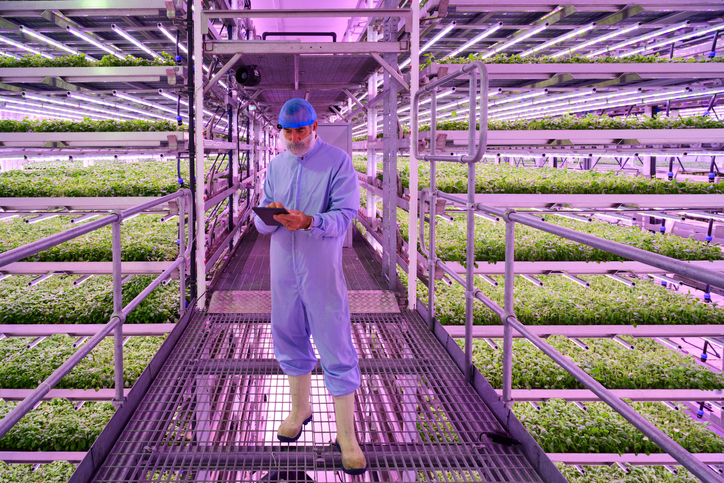Article
The most exciting growth sectors in AgTech
04 Oct, 20215mins
In order to keep up with population growth over the next thirty years, the world’s food systems will have to produce 70% more than they currently do. The solution is agricultural technology (AgTech) — an industry that utilises technology to produce food more efficiently in the face of climate change. The UAE has led the investment into AgTech, announcing a plan for 50% of all food in the emirates to be produced locally by 2051. This is ambitious, considering that currently, only 20% is produced locally, and the region suffers from a shortage of arable land. However, this is where technology can help. Let’s look at some of the most exciting AgTech developments and how these fields could progress going forward.
Vertical farming
Vertical farming refers to growing produce in stacked layers, usually in combination with other high-tech solutions such as automated LED lighting. It is a great way to re-purpose old skyscrapers, warehouses, shipping containers and more — making it ideal for locations short on space. However, vertical farming really comes into its own in difficult weather conditions. Recently, construction began on what is set to become the world’s largest indoor vertical farming unit in Abu Dhabi. The ability of these indoor systems to withstand extreme climate conditions makes them highly valuable, especially as pressure to produce locally increases (thereby reducing the carbon cost of production and reliance upon imports).
The biggest barrier to vertical farming is the cost. Not only do firms in this area bear the expense of the premises, but it can take time to fine-tune automation and watering processes. However, this doesn’t seem to have dissuaded the UAE, which invested $100 million in vertical farming in 2020. The global vertical farming market was reported to be worth $3 billion in 2020 and is estimated to grow to £18 billion by 2030. While initially expensive, the promise of weather-resistant vertical farming in areas with non-arable land, high temperatures, and water scarcity offers long-term benefits likely to outweigh this investment.
Smart greenhouses
An average kilogram of tomatoes takes 214 litres of water to grow, but this can be reduced to just four litres in a smart greenhouse. These high-tech buildings utilise sensors to regulate heat, humidity and light automatically. Luna by iUNU uses robots to scan crops several times daily and then uses artificial intelligence (AI) to respond to status changes. In another example, Bold Robotic Solutions uses AI to monitor equipment and respond to inefficiencies in real-time.
Smart greenhouses are often considered less exciting than vertical farming. It is true that much of the technology overlaps, as AI solutions are often used in vertical farming. However, building a single layer of vertical farming can sometimes be as expensive as building an entire greenhouse. Where there isn’t the need for space and to grow completely without sunlight, smart greenhouses can be a more cost-effective option. Research and development in this area is particularly strong in the Netherlands, as the government invested in smart greenhouses after World War Two's famine. However, growth is slower than vertical farming: the market was reported to be worth £1.37 billion in 2019 and is estimated to reach £3.23 billion in 2027.
Alternative proteins
On a slightly different track, alternative proteins refer to plant-based (fungi, bacteria and yeast-based proteins) and animal-cell-derived meat products. According to Boston Consulting Group, these alternatives will make up at least 11% of the protein market by 2035 — up from 2% in 2020. This shift will have significant environmental impacts, such as reducing carbon dioxide production and water consumption.
Some of the main barriers to alternative proteins include the quality — uptake is still low due to the taste and texture of some products. In addition, many alternatives are expensive, particularly animal-cell-derived products. However, with a potential market of $290 billion by 2035, the opportunities for agricultural technologists are promising.
AgTech is a relatively new but quickly growing industry. The pressure of climate change will only increase the need for technological solutions. Those with skills in AI, data science, manufacturing and more will find themselves in high demand for years to come.
If you are an AgTech professional or your company is looking to grow its tech teams, contact McGregor Boyall today and find out how our expert recruiters can help you.


